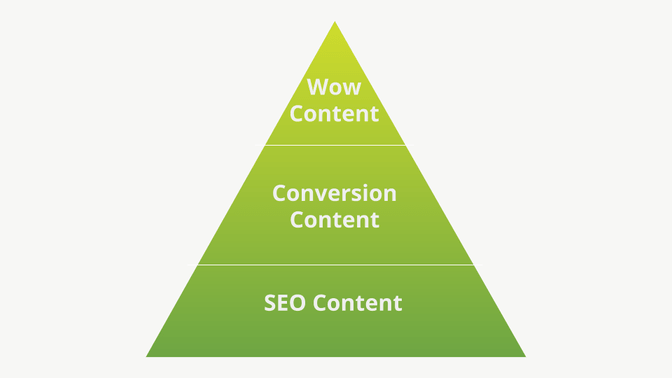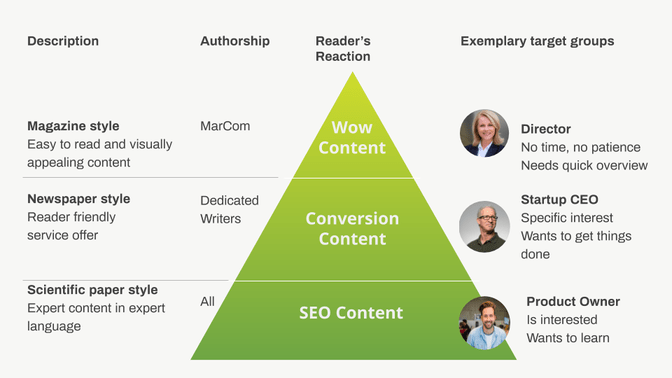The design may be great, the topics may be exciting – but if your editorial planning is weak, your website will not flourish. Only exciting, informative and constantly updated content will turn visitors into fans and fans into clients. And only search-engine-optimised content will ensure that people find your website. It is therefore vital to think about editorial planning right at the beginning of a web project. Liip’s content governance model helps with this. It summarises how the editorial team is structured, where its focus lies, and who is in charge of which area – so that day-to-day editorial planning can be easily derived from it, and the editorial team is given real support.

Identify different content requirements
The content of a website must meet various requirements. It must captivate visitors, appear high-quality and entertaining – and ideally, the editorial planning will include a high proportion of images and videos. This is complex, time-consuming and expensive. At the same time, the content must be constantly updated and have a high proportion of text in order to be found by search engines. It is no longer enough just to incorporate a weekly blog post into editorial planning. High-quality but speedy, image-heavy but text-based – editorial planning has to meet conflicting expectations. To allow the editorial team to do their work, we have to identify these opposites and take them into account in editorial planning. This is what a clear governance model does.
Identifying different user groups’ requirements
Visitors also have varying needs and expectations from a website. Our editorial planning work at Liip therefore takes three requirement groups into accounts.

Requirement group A: impatient visitors want ‘wow’ content
The ‘impatient visitors’ user group just wants to quickly scan a website to get an idea of what a company stands for. They visit a website with the attitude that they only want to have a quick browse. They need to be wowed quickly – and their questions will already be answered. If their expectations are met, they are prepared to dig deeper into the materials available and switch to the category of ‘inquisitive visitors’ (see requirement group C), or will readily move straight to a transaction and switch to the group of ‘visitors who are willing to buy’ (group B).
Content requirements for editorial planning: ‘Glossy magazine style’ – entertaining, inspiring, emotional content that is easy to grasp and understand. Preferably with lots of images and/or videos and not much text.
Content style for editorial planning: Content that is time-consuming to produce, as it has a high proportion of images and videos and the language calls for marketing expertise. A good way of attracting impatient visitors is to use stylistic tools such as storytelling or headlining. Search-engine-optimisation is not recommended, as this type of content does not generally contain much text.
Ownership for editorial planning: Communication or marketing team
Governance positioning for editorial planning: ‘Wow’ content is time-consuming to produce, so only a few select pages are devoted to it. They stay on the website for a long time and do not change much. They form the top of the governance pyramid – pages that are few in number, but most significant for implementation.
Requirement group B: soon-to-be customers want clear instructions
The user group of ‘visitors who are willing to buy’ generally start off being impatient or inquisitive visitors. Alternatively, they might already be aware of your company. They are prepared to begin an exchange with your company. This may mean purchasing an actual product, subscribing to the newsletter or making contact. They want clear instructions to enable them to achieve their goal quickly and pleasantly.
Content requirements for editorial planning: ‘Newspaper style’ – no-nonsense content with graphics, images and/or videos where required, and clear calls to action.
Content style for editorial planning: Carefully prepared content, ideally produced by a UX writer – someone who specialises in process descriptions and clear instructions. Search engine optimisation is recommended for long tail keywords, to ensure that users looking for a specific product or contact person will find them immediately via a search engine.
Ownership for editorial planning: UX writer
Governance positioning for editorial planning: Conversion content must be carefully prepared, but is not particularly time-consuming. It is also possible to estimate the number of these content pages. Conversion content therefore forms the middle of the governance pyramid – pages that are medium in number, with medium significance for implementation.
Requirement group C: inquisitive visitors want depth
The user group of ‘inquisitive visitors’ wants to delve deep into the available materials and really learn something. They visit a website with the attitude that they want to linger and read. They are looking for added value in the content. If they find it, they are willing to go deeper or look around further. They are only willing to begin a transaction if this is achieved, and only after multiple visits to your website. The good thing about expert content is that it is very text-heavy. This is relatively cheap to produce and can therefore be created more quickly than content for groups A or B. The high proportion of text makes this content type ideal for search engine optimisation.
Content requirements for editorial planning: ‘Trade journal style’ – long articles in expert language, using expert terminology and with few pictures or videos.
Content style for editorial planning: As our readers are willing to invest time in expert content, the style is relatively easy: the focus is on text production. It is the content that needs to impress, and not an attractive design or fantastic images. However, this means that search engine optimisation is a top priority. This is because visitors search for expert knowledge via Google, so this content style should appear at the top of search results.
Ownership for editorial planning: Subject experts
Governance positioning for editorial planning: Expert content requires a high level of specialist knowledge, but because the focus is on text production, it is relatively quick and cheap to produce. Expert content therefore forms the base of the governance pyramid: lots of pages that can be produced quickly.

Lessons learned
Modern content needs to satisfy a range of different requirements. On the one hand, it must contain a high proportion of images and videos, and must inspire. On the other hand, long sections of text are crucial, because they allow search engines to classify and rank the content. Clear content governance helps to meet these requirements for the long term, and ensure that editorial planning has a strategic orientation.

